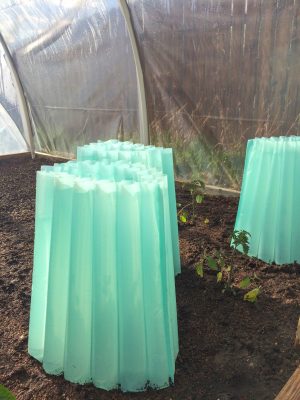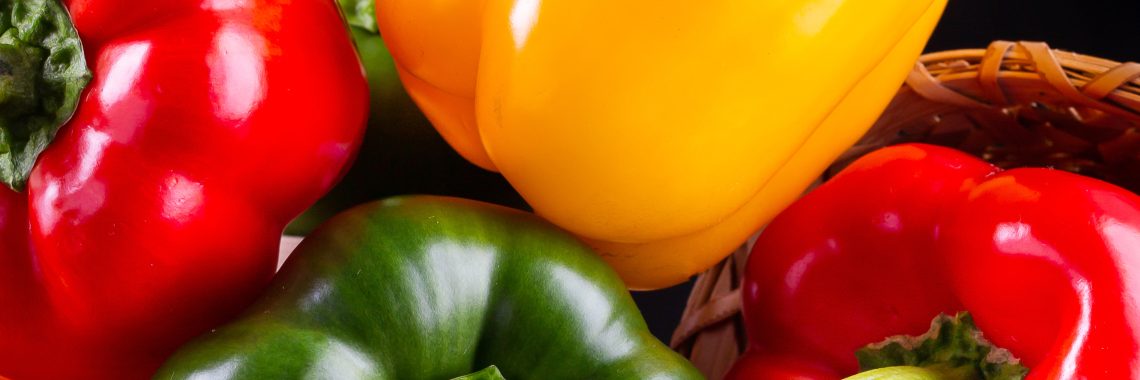Originally from Central America, pepper plants (Capsicum annuum) have made their way into garden beds all over the world, including in Wyoming.
Peppers can be grown for fresh eating and cooking, or dried as a spice. Available in a wide variety of shapes, sizes, and colors, all pepper fruits start out green. As they ripen, they can stay green or change to red, orange, yellow, or other colors. There are hundreds of different varieties.
Varieties are split into sweet and hot categories. Hot peppers can vary drastically in heat and their degree of “hotness” is reported in Scoville Heat Units (SHU). For example, jalapeños can be in the 1,000 to 10,000 SHU range, while habaneros can reach 350,000 SHU. Bell peppers fall into the sweet category, with a SHU of zero.
Select varieties according to the desired use of the pepper, length of your growing season, growing conditions in your area, the level of heat you want, and the resources available for keeping plants healthy.
Common varieties of peppers
Numbers in parentheses are approximate days to maturity.
Sweet
- Crispy Bell (65)
- King of the North (65)
- Sweet Banana (68)
- Purple Bell (70)
- Bell Boy (70)
- Lady Bell (72)
- California Wonder (75)
- Lipstick (75)
Hot
- Anaheim 118 Hybrid (65)
- Early Jalapeño (66)
- Big Chili (68)
- Masivo Hybrid (70)
- Garden Salsa Hybrid (73)
- Cayenne (73)
- Red Chili (84)
Temper(ature) tantrums
Peppers can be a challenge to grow in cooler parts of Wyoming; night temperatures are a major issue. Once night temperatures are below 60 degrees, pollen production is affected, and pepper blossoms often fall off. Pepper plants are less productive when night temperatures fall below 55 degrees Fahrenheit and will slowly start to die once temperatures drop below 40 degrees. Ideal growing temperatures are between 70 and 90 degrees during the day and 60 to 70 degrees at night.
Temperatures above 90 degrees during the day can also cause blossoms to drop. Hot peppers do well in temperatures even warmer than those sweet peppers can tolerate and will set fruit at temperatures above 90 degrees. With a narrow range of ideal temperatures, the addition of warming or cooling methods is important for pepper production in Wyoming.
Black plastic mulch, natural material mulch, row covers, season extension structures, moving plants indoors at night, walls of water, and other heating methods can be used for keeping pepper plants warm during cooler temperatures. If peppers are grown indoors, then mechanical agitation (gentle shaking from a fan) of blossoms may be required to ensure adequate pollination and fruit set.
Shade cloth or other cooling methods should be used when temperatures become too warm for proper flower function. Wind can damage plants (they are brittle and break easily), so look for ways to help keep plants protected in the windy portions of Wyoming. Peppers grow best in nutrient-rich, well-drained soils with adequate moisture throughout the growing season. Too much irrigation will cause the flowers to abort, and fruit to grow erratically or not mature fully. Inconsistent irrigation can cause blossom-end rot.
 Growing peppers in cold environments
Growing peppers in cold environments
For my personal garden in Laramie, Wyoming, the best chance for avoiding a frost is from June 14 to September 5. Nighttime temperatures are often below 60 degrees Fahrenheit on a regular basis. At an elevation of 7,000 feet, warm season crops like peppers require season extension structures and other methods of extending the growing season. I have experimented with various season extension methods to produce a reliable pepper crop. My best results have come from using a hoop-style low tunnel that is 8 feet wide, 10 feet long, and 6 feet tall. The tunnel is covered with a flexible greenhouse plastic.
The largest and most consistent production of peppers comes from plants that are grown in plastic structures that hold water (walls of water) that are placed within the low tunnel. Comparing sweet pepper plants of the same age, size, and flowering date, I have noticed that peppers grown with walls of water are often four times as large as peppers grown without walls of water. They also often produce about twice as many peppers compared to plants grown without walls of water in the same low tunnel. I have observed similar results for hot pepper plants.
For gardeners who live in warmer and more mild climates such precautions may not be necessary. However, for those in more challenging areas of our state, extra care and precautions are often required to successfully grow peppers.
Planting
Peppers can be seeded directly into the ground or transplanted with immature plants. Pepper seeds germinate best when soil temperatures are between 70 and 72 degrees Fahrenheit. Due to environmental constraints, transplants started from seed indoors or purchased are generally the best options in Wyoming. When purchasing, look for plants that have hardy stems, are free of disease and pests, and do not have flowers, since the existing flowers will generally fall off once transplanted. Transplants should have five to six true leaves. Plants should be planted outside when all chances of frost have ended (visit Wyoming Vegetable & Fruit Growing Guide at bit.ly/WY-fruit-veg for frost tables specific to your area). They should be placed 12 to 24 inches apart depending on the variety. Peppers can be planted in rows 18 to 36 inches apart. Seeds should not be planted more than ½ inch deep if directly seeded.
Harvest
The timing of pepper harvest depends on their intended use. Sweet peppers can be harvested once they are 3 to 4 inches long. Use scissors, pruning shears, or a knife to cut them from the stem. They will also snap off the stem when ripe. Some types of sweet peppers are harvested before maturity to maintain a desired color or shape. All pepper fruit should be firm, smooth, and full when harvested. Fresh peppers do not have a long storage life (1 to 2 weeks).
Use rubber gloves to protect your skin when picking or harvesting hot peppers. Wash your hands after handling hot peppers to avoid contact of irritating pepper chemicals with eyes and sensitive skin. If drying and grinding hot peppers, be sure to take adequate precautions to protect yourself from the pepper dust created during the grinding process.
Unfortunately, peppers grown in Wyoming may encounter diseases and harmful insects. For more information on these issues, please refer to the Wyoming Vegetable & Fruit Growing Guide at bit.ly/wy-fruit-veg-guide.
Brian Sebade is a University of Wyoming Extension educator and can be reached at (307) 721-2571 or bsebade@uwyo.edu. He’d take a bell pepper over a ghost pepper any day.
Article originally published in Barnyards & Backyards magazine, Summer 2022 issue.





